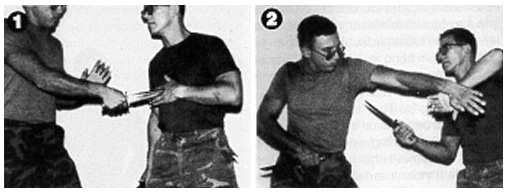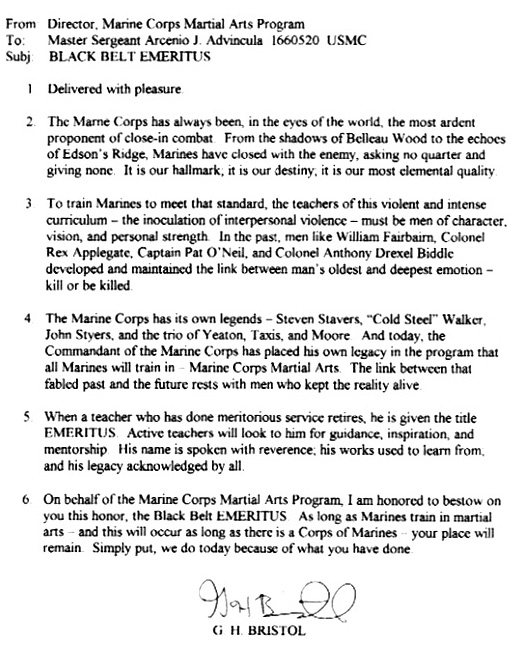Marine Combat
Fighting Tatics • Knife Tactics • Black Belt EmeritusMARINE COMBAT INSTRUCTION Marine News
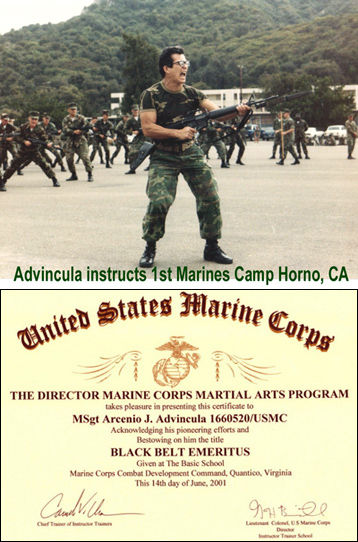 The "Isshinryu No Megami" (Goddess of Isshinryu). The vision of Shimabuku Tatsuo Sensei to represent his Isshinryu Karate system.
The "Isshinryu No Megami" (Goddess of Isshinryu). The vision of Shimabuku Tatsuo Sensei to represent his Isshinryu Karate system.
The patch or crest worn by Isshinryu karateka often raises admiration and curiosity. The patch is based on a day dream Tatsuo Shimabuku had in the fifties while he was creating his karate style. This dream was the missing piece in the puzzle called Isshinryu. The patch is often called Mizu Gami, which means 'water goddess'. Originally the Isshinryu emblem was called 'Isshinryu No Megami', which means 'Goddess of Isshinryu'. However; most Isshinryu karateka incorrectly call it Mizu Gami, or 'Water Goddess'. Master Eiko Kaneshi, Tatsuo's right-hand-man who is a Shinto priest when asked if it was 'Mizu Gami' said it has nothing to do with water. Isshinryu no Megami or Megami for short, is correct. This is collaborated by Marien Jumelet who asked Shinsho Shimabuku and Kensho Tokumura what was the correct name. The goddes is the Goddess of Isshinryu karate and not the goddess of water.
Submitted by: MCB Camp Pendleton - Story Identification Number: 2001329185251
Story by Sgt. Joe A. Figueroa
MARINE CORPS BASE CAMP PENDLETON (March 29, 2001) -- The concept of a martial arts program for the Marine Corps is not new and has been practiced in one way or another for quite some time under the guise of close combat training.
The only difference now is that the Commandant has made it into standard training Corps-wide. However, the evolution of the martial arts program has never been easy and took quite a long time for the realization to come about. Former Marines like retired gunnery sergeant, Bill Miller, and retired master sergeant, Jim Advincula, who both received a "Black Belt Emiritus" award recently for their pioneering efforts in martial arts. They first breathed life into the program by incorporating their lessons according to the needs of the Marine Corps. "In the old days, it used to be that if you were a Marine who knew martial arts then you were given the task of teaching it to other Marines," Advincula said. It is this reason that for several years a martial arts program was never in place, but taught. However, in most cases it was left up to the unit's commanding officers to incorporate that type of training.
Although Miller learned his skills while on Marine Security Guard duty in Bangkok, Siam; Advincula started his journey early in life. Ironically, they both learned their skills in the same area... Southeast Asia. Advincula began his journey at the age of eight when a few friends of his in the Philippines took his hat and jacket. His father, a civilian worker for the Army Air Corps, was upset about the situation and quickly retrieved his son's belongings. However, it was this incident that spurned Advincula's father to hire a few close friends in the Philippine Army to coach him. "I had several people teach me different ways in the Escrima martial art and combat judo," Advincula said.
Practicing his art until he entered the Marine Corps in 1957 as a combat engineer, Advincula eventually found himself on Camp S.D. Butler, Okinawa. It was here that he began teaching his first lesson. "I took the best that each martial art had to offer and quickly created a system for use (in Okinawa)," Advincula said. Recognizing faults in the hand-to-hand combat fighting technique the Marine Corps was teaching at the time, Advincula made a concerted effort to teach wherever he went in his 24 years of service "I had a big problem with hand-to-hand combat. The Marine Corps taught that you had to take a 'stance.' That's unrealistic because people don't fight that way. I was finding that a lot of Marines came in to learn how to fight and they found themselves disappointed," Advincula said.
For example, MSgt Richard A. Pittman, now retired, recounted an experience while serving in Vietnam. When a North Vietnamese Army (NVA) prisoner bolted, Pittman, guarding the prisoner, found himself in pursuit. After running the prisoner down, it was obvious that the prisoner was not about to give up. Pittman incorporated his hand-to-hand Marine Corps combat training and quickly found that none of the techniques were working. Pittman stated, "As I was fighting him, I was trying to think what I was supposed to do, like when he reaches out with his right hand I am supposed to grab him with my left hand, etc. That stuff just didn't work. I tried to use everything the Marines taught me, but it just wouldn't work." It was that experience that caused Pittman to stress the extreme violence that close combat entails and to become a staunch advocate on close combat teachings. It was also that experience that convinced Advincula, an acquaintance of Pittman's, that things had to be done differently. Although he was only one man, upon coming home from Vietnam, Advincula continued his teachings to Marines. "Many people believe that if you teach a Marine how to kill with his bare hands that he will go out and use it. What they don't understand is that the martial arts instill discipline. By learning how to fight, you don't want to fight," Advincula said.
Nevertheless, the importance of using an issued weapon before martial arts was stressed in his teachings. "A Marine should use his weapon until it can't be used anymore. After that, he should take the enemies weapon away and use that. After that, he should improvise and use whatever is around. Once all the Marine's options are exhausted then he should use his hands," Advincula said. It was this type of philosophy a lieutenant colonel experienced firsthand as commanding officer of 3rd Battalion, 9th Marine Regiment. This officer is now our 32nd Commandant and although Gen. Jones had already made up his mind about martial arts as a young lieutenant in Vietnam, he described the experience at 3/9 as "startling," according to a recent USA Today edition.
Today, Advincula is quite pleased the Marine Corps has finally adopted an official martial arts program and hopes that it will remain for years to come. "I don't know if I had anything to do with it, but it's what I've been saying for years," Advincula said.
Included among close-combat expert Jim Advincula’s favorite fighting blades are the Bush Knife (top), Kukri (second from top) Bolo (third from top), K-Bar (fourth from top), and Randall Model 1 (bottom). According to United States Marine Corps close-combat instructor Jim Advincula, all knives are not created equal. Following are a few of Advincula's favorite fighting knives:
- MKI “Trench Knife.” First manufactured in France in 1918 for allied forces during World War I, this knife is designed for infighting.
- K-Bar. An excellent choice for both fighting and utilitarian needs, such as opening cans of C rations. The blade is soft, but hard to break. The blade dulls easily, however.
- Pilot survival knife. Designed as a simple, sturdy survival aid, this knife's short length makes it an excellent choice for use in vehicles such as tanks, personnel carriers, etc.
- Randall Model 1. First produced during World War II, the Randall was also popular in Vietnam and remains a weapon of choice among today's soldiers. Featuring a double edge, it is an excellent all-purpose knife.
- Kukri. The single-edged kukri, or Gurkha knife, is outstanding for chopping and ideal for jungle work.
- Bolo. Double-edged, the bolo can be used for thrusting or chopping, or even as a Jungle- knife.
- Bush knife- First used in World War II, this knife can be used to chop or slash, or can be incorporated with a punching technique. It is not effective for thrusting maneuvers, however.
- Randall Model 2- Extremely strong, this knife is hefty enough for chopping or slashing techniques.
- Gerber (Vietnam era). This knife offers a non-slip oval grip that enables the user to know where the cutting edge is located.
- Modern Gerber. This knife is an improvement over the earlier Gerber model because of its stronger blade, serrated edge for cutting rope, and other enhancements.
- Russell heavy-duty dagger. This knife can be used as a short sword and can thrust or slash through heavy clothing.
- Boot knife. Although unsatisfactory as a combat knife, this small blade can come in handy as a last resort.
The Knife Fighting Tactics of the US Marine Corps: Grips, Stances and Targets/ by Robert Safreed Advincula's Oceanside, California martial arts school is located near a military base, and the isshin-ryu karate and escrima instructor is frequently called upon to teach UPS. servicemen the finer points (excuse the pun) of knife fighting. Following are some of the major principles Advincula covers with his trainees. Stance Covering Shield Hand Targets Jim Advincula (left) demonstrates the "triangle" stance, with his knife to the front and shield hand covering his chest. This is the preferred knife-fighting stance. Standing with the free hand forward (center) rather than the knife hand, or using a reverse grip (right) is not recommended. There are four basic methods of gripping a knife: the reverse grip (1), the fencer's grip (2), the ice pick grip (3) and the hammer grip (4). The hammer grip is the preferred method because you are less likely to lose your grasp of the weapon and you can use the knife in combination with a punch.
Advincula also teaches students to aim for the opponent's weapon-wielding hand. By disabling the hand that holds his weapon, you neutralize the threat to your safety and gain the advantage. If the enemy has two weapons- say a pistol in one hand and a knife in the other- zero in on the one that presents the most immediate danger to your well-being. In the "shield hand" technique, the knife fighter places (1) his free hand close to his heart or solar plexus to protect vital areas from his opponent's Knife strikes. Or, he can use the free hand to parry (2) an opponent's strike, and then counterattack.
Caption p.59 bottom There are four basic methods of gripping a knife: the reverse grip (1), the fencer's grip (2), the ice pick grip (3) and the hammer grip (4). The hammer grip is the preferred method because you are less likely to lose your grasp of the weapon and you can use the knife in combination with a punch. Caption p59top Caption p.60 In the "shield hand" technique, the knife fighter places (1) his free hand close to his heart or solar plexus to protect vital areas from his opponent's Knife strikes. Or, he can use the free hand to parry (2) an opponent's strike, and then counterattack.FIGHTING KNIVES
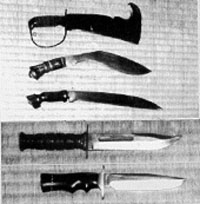
KNIFE TATICS
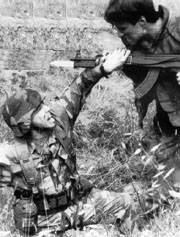 It's midnight in the jungle, and a United States Marine Corps infantryman crouches in the grass. His M16 assault rifle, emptied of bullets, lies somewhere in the thick underbrush, near the bodies of the soldier's slain enemies. He is alone, and he is far from home, behind enemy lines. Yet he is unafraid. He still has his knife, and in close combat, that is all he needs.
It's midnight in the jungle, and a United States Marine Corps infantryman crouches in the grass. His M16 assault rifle, emptied of bullets, lies somewhere in the thick underbrush, near the bodies of the soldier's slain enemies. He is alone, and he is far from home, behind enemy lines. Yet he is unafraid. He still has his knife, and in close combat, that is all he needs.
According to Jim Advincula, a longtime U.S. Marine Corps knife and close - combat instructor, basic knife-fighting techniques are far more effective in close-combat situations than fancy or advanced techniques. For the average grunt, simple is deadly.
Grip
The first thing Advincula shows his knife-fighting students is how to grip the weapon. The terrain and environment are rarely ideal for close combat. Rain, mud or snow will make the handle of a knife slippery and difficult to manage, and wearing gloves only makes it more difficult to wield the weapon efficiently.
Technique #1
Therefore, it is necessary to select a simple, strong grip which can be used in any situation. Close-combat instructors generally teach four methods of grip- ping a knife:
Reverse grip - Some instructors advocate the use of the "reverse" grip, with the knife held along the wrist. However, Advincula claims this method limits your techniques and only allows for slashing maneuvers, which are usually ineffective in a close-combat situation because the blade doesn't penetrate the target or generate much power.
Fencer's grip - Most instructors teach the “fencer's” grip, in which the knife handle is gripped firmly between the thumb and forefinger, with the other fingers wrapped loosely around the handle. While this grip may be suitable for small knives like a stiletto, it isn't suitable for blades with large grips. If your hand is hit during combat while employing the fencer's grip, you can lose your grasp on the weapon.
Ice-pick grip - The "ice-pick" grip enables deep penetration against soft body armor, heavy clothing, or other protective outfits.. To achieve this grip, simply hold the knife handle in a fist, with the blade pointing down. There are drawbacks to this grip, however. When raising the knife for a downward strike, you not only telegraph your intentions and expose your chest area, but you also make it easy for your opponent to see the weapon. Moreover, the ice-pick grip does not provide parrying or thrusting capability, and it is easier for the opponent to block a knife strike delivered in this manner.
Hammer grip - The hammer grip is preferred over all others. A knife held in this fashion is less likely to be knocked from your grasp, and can also be used in conjunction with a punch or to deliver butt-end knife strikes. A hammer grip is achieved by grasping the knife at the handle and forming a tight fist. Keep the wrist flexible, as if using a hammer or hatchet. This enables you to lock the wrist tightly when needed.
The hammer grip provides great penetration and power, allowing the blade to easily cut through heavy clothing. There is also less likelihood of injury to the user's thumb, unlike with the fencer's grip. The hammer grip can be used for chopping, slashing, and especially thrusting techniques.
Jim Advincula (left) demonstrates the "triangle" stance, with his knife to the front and shield hand covering his chest. This is the preferred knife-fighting stance. Standing with the free hand forward (center) rather than the knife hand, or using a reverse grip (right) is not recommended.
After achieving an effective grip, the knife fighter must assume an appropriate combat stance. Advincula teaches Marines to fight from a basic "triangle" stance. Also known as the "fencer's" stance, the triangle posture allows the knife fighter to move in any direction at a moment's notice. This stance also allows the practitioner maximum reach because his knife is held in the hand nearest to the enemy.
Advincula teaches students to "hide" behind their knife; in other words, keep the weapon between them and the opponent. By keeping the knife pointed toward the enemy, you can attack and/or block or parry any thrusts by the opponent. You can also pull the weapon close to your body, leaving your free hand to protect against an opponent's grabbing technique.
The knife fighter's free hand should be held close to the heart or solar plexus to protect vital areas such as the heart and throat. Should the enemy's blade get through your defenses, your free hand will hopefully absorb the blade ra- ther than one of your vital organs. This technique is taken from Filipino escrima, in which the hand is used as a shield and is sacrificed, if necessary. According to Advincula, the escrimador's credo is: "You can cut my hand, but I will take your life!"
The knife fighter's "shield hand" can also be used to parry, punch, fake a blow, throw objects, distract the opponent, or assist balance in rough terrain. Marines are even taught to grab the opponent's blade, if necessary. It should be noted that your hand can't be cut unless the enemy is able to draw his blade. By grabbing and attacking the opponent, you can prevent him from drawing the weapon and cutting your hand.
Attacking the right targets is a key to effective knife fighting. The objective is to neutralize the enemy as quickly as possible, but this does not mean always attempting to strike vital points. Since the enemy will generally be defending his vital points, you should seek the most available target, be it the solar plexus, back, neck, stomach, etc. Drawing first blood is a tremendous psychological advantage. The more you strike your opponent- regardless of where you hit him- the more he will bleed and weaken.
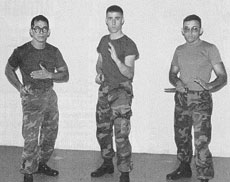

Technique #2
The official motto of the U.S. Marine Corps is semper fidelis, a Latin phrase meaning "always faithful." By practicing the basic principles of close-combat knife fighting—proper grip, balanced stance, accessible targets—you too can be assured that your knife will always be "faithful," be it in the jungle, or on the streets.
